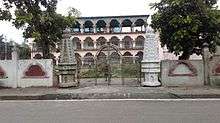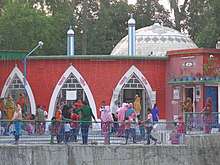Rajshahi
| Rajshahi | |||||||||
|---|---|---|---|---|---|---|---|---|---|
| City | |||||||||
| |||||||||
| Nickname(s): Silk City | |||||||||
 Rajshahi Location of Rajshahi in Bangladesh | |||||||||
| Coordinates: 24°22′N 88°36′E / 24.367°N 88.600°ECoordinates: 24°22′N 88°36′E / 24.367°N 88.600°E | |||||||||
| Country | Bangladesh | ||||||||
| Division | Rajshahi Division | ||||||||
| District | Rajshahi District | ||||||||
| Establishment | 1700 | ||||||||
| Municipality | 1876 | ||||||||
| Granted city status | 1991 | ||||||||
| Government | |||||||||
| • Type | City Corporation | ||||||||
| • Body | Rajshahi City Corporation | ||||||||
| Area[1] | |||||||||
| • City | 96.68 km2 (37.33 sq mi) | ||||||||
| Elevation | 18 m (59 ft) | ||||||||
| Population (2011)[2] | |||||||||
| • City | 763,952 | ||||||||
| • Density | 7,900/km2 (20,000/sq mi) | ||||||||
| • Metro | 878,500 | ||||||||
| Time zone | BST (UTC+6) | ||||||||
| Postal code | 6000, 6100, 6203 | ||||||||
| National Calling Code | +880 | ||||||||
| Calling Code | 0721 | ||||||||
| Police | Rajshahi Metropolitan Police | ||||||||
| Airport | Shah Makhdum Airport | ||||||||
| Website |
erajshahi | ||||||||
Rajshahi; historically Rampur Boalia; nicknamed Silk City) is a metropolitan city in Bangladesh and a major urban, commercial and educational centre of North Bengal. It is the administrative seat[note 1] of Rajshahi Division and Rajshahi District. Located on the north bank of the Padma River, near the Bangladesh-India border, the city has a population of over 763,952 residents.[3] The city is surrounded by satellite town of Nowhata and Katakhali, which together build an urban agglomeration of about 1 million population.
Modern Rajshahi lies in the ancient region of Pundravardhana. The foundation of the city dates to 1634, according to epigraphic records at the mausoleum of Sufi saint Hazrat Shah Makhdum (R). The area hosted a Dutch settlement in the 18th century.[4] The Rajshahi municipality was constituted during the British Raj in 1876. It was a divisional capital of the Bengal Presidency.
Rajshahi is an important administrative, educational, cultural & business centre in Bangladesh today. It is a historic center of silk production. Varendra Research Museum, which is oldest of its kind in Bangladesh is located in the city. The city is home to many renowned educational institutions of Bangladesh. The head office of Rajshahi Agricultural Development Bank and Barind Multipurpose Development Authority (BMDA) is situated in the city. Rajshahi is served by the Shah Makhdum Airport.
History
Rajshahi district was a part of the Pundra region of ancient Bengal. The capital of Vijay Sen, the king who led military operations in Sri Lanka and Southeast Asia was located 9 miles (14 km) to the west of Rajshahi town. In medieval times, the region came to be known as "Rampur Boalia". The origin of the present name of "Rajshahi" is debated among scholars. Most say that it takes its name from Hindu Kings and zamindars (or "Rajas") as Raj and the persianised Shahi; both of which means Royal or Kingdom.[5] The administrative district was established in 1772 and the municipal corporation in 1876. Rajshahi was dominated by various Maharajas, Rajas and Zamindars.[6]
It was made a city corporation in 1991. During the British Raj, it was also known as "Beuleah" and was the administrative headquarters of Rajshahi district in Eastern Bengal and Assam. It was originally chosen as a commercial factory for the silk trade, which was being officially encouraged by the agricultural department of that time. The town contained a government college, and an industrial school for sericulture. Most of the public buildings were severely damaged by the earthquake of 12 June 1897.[7] Throughout much of the early part of the twentieth century there was a daily steamer service on the Ganges which connected it to rail-heads that led to the then provincial capital of Calcutta as well as other cities in the province of Bengal.
Along with all of Bangladesh, Rajshahi witnessed both great atrocities by the Pakistan army and heroic struggles by the freedom fighters during the liberation war in 1971. The largest mass grave in Bangladesh is located in Rajshahi University, which was used as an army camp during the war. On the other hand, one of the great battles of the war took place near Rajshahi. Captain Mohiuddin Jahangir, who died in battle, was awarded the highest honour (Bir Shrestho) by the Bangladesh government after the war.
Geography
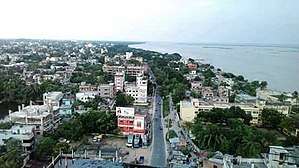
Topography
Geographically Rajshahi is situated within Barind Tract, 23 m (75 ft) above sea level & lies at 24°22′26″N 88°36′04″E / 24.37389°N 88.60111°E.The city is located on the alluvial planes of the Padma river, which runs through southern side of the city. It is bounded on the east, north and west by Paba Upazila (subdivision of a district) of the district.
Climate
Under Köppen climate classification, Rajshahi has a tropical wet and dry climate. The climate of Rajshahi is generally marked with monsoons, high temperature, considerable humidity and moderate rainfall. The hot season commences early in March and continues till the middle of July. The maximum mean temperature observed is about 32 to 36 °C (90 to 97 °F) during the months of April, May, June and July and the minimum temperature recorded in January is about 7 to 16 °C (45 to 61 °F). The highest rainfall is observed during the months of monsoon. The annual rainfall in the district is about 1,448 millimetres (57.0 in).[8]
| Climate data for Rajshahi | |||||||||||||
|---|---|---|---|---|---|---|---|---|---|---|---|---|---|
| Month | Jan | Feb | Mar | Apr | May | Jun | Jul | Aug | Sep | Oct | Nov | Dec | Year |
| Record high °C (°F) | 30.0 (86) |
35.4 (95.7) |
40.3 (104.5) |
45.1 (113.2) |
44.8 (112.6) |
43.6 (110.5) |
39.7 (103.5) |
35.5 (95.9) |
39.2 (102.6) |
35.3 (95.5) |
34.3 (93.7) |
30.3 (86.5) |
45.1 (113.2) |
| Average high °C (°F) | 25.4 (77.7) |
28.0 (82.4) |
33.5 (92.3) |
35.9 (96.6) |
34.8 (94.6) |
33.3 (91.9) |
32.0 (89.6) |
32.0 (89.6) |
32.3 (90.1) |
31.9 (89.4) |
29.5 (85.1) |
26.1 (79) |
31.23 (88.19) |
| Daily mean °C (°F) | 18.5 (65.3) |
20.6 (69.1) |
25.7 (78.3) |
28.8 (83.8) |
29.1 (84.4) |
29.4 (84.9) |
28.9 (84) |
29.1 (84.4) |
29.1 (84.4) |
27.6 (81.7) |
23.5 (74.3) |
19.4 (66.9) |
25.81 (78.46) |
| Average low °C (°F) | 10.2 (50.4) |
13.3 (55.9) |
18.0 (64.4) |
21.7 (71.1) |
23.5 (74.3) |
25.5 (77.9) |
25.9 (78.6) |
26.2 (79.2) |
25.9 (78.6) |
23.4 (74.1) |
17.6 (63.7) |
12.8 (55) |
20.33 (68.6) |
| Record low °C (°F) | 1.8 (35.2) |
3.9 (39) |
8.6 (47.5) |
10.8 (51.4) |
14.4 (57.9) |
20.3 (68.5) |
19.4 (66.9) |
18.3 (64.9) |
12.6 (54.7) |
11.4 (52.5) |
7.0 (44.6) |
4.2 (39.6) |
1.8 (35.2) |
| Average precipitation mm (inches) | 13 (0.51) |
15 (0.59) |
27 (1.06) |
39 (1.54) |
129 (5.08) |
272 (10.71) |
301 (11.85) |
261 (10.28) |
234 (9.21) |
112 (4.41) |
14 (0.55) |
2 (0.08) |
1,419 (55.87) |
| Average relative humidity (%) | 40 | 35 | 37 | 40 | 51 | 79 | 88 | 85 | 80 | 66 | 62 | 59 | 60.2 |
| Source: WeatherBase.Com | |||||||||||||
Although once noted for its air pollution, since 2014 the levels of particulates have been dramatically reduced by various efforts to switch to cleaner fuels and to battery-powered vehicles, to pave earth streets, to encourage walking and bicycle transport, and to plant vegetation.[9] The levels of PM10 dropped by 67% and PM2.5 which are particularly harmful to human health, dropped from 70 to 37 micrograms per cubic metre between 2014 and 2016.[9]
Parks and greenery
A central park Shahid Qumruzzaman central park and zoo is one of the popular public place of Rajshahi city. A wide area with lush green trees and grasses also houses different animal species. It is located by the bank of river Padma. There are other parks in the city such as Bhubon Mohon park, Captain Monsur Ali park etc. There is a park specially designed for the children's amusement called Shahid Zia children's park. Bank of the Padma river along the city is also very popular destination for recreation too. The bank is planned zone in many parts of the city to accommodate city dwellers for recreation purposes. As example Munsguard park near magnificent old Dutch borokuthi building and Lalonshah park near shahmukhdum eidgah are recently build to give city people a nice place to enjoy the magnificent views of padma river.
Points of interest

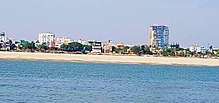
- Banks of the Padma River: A lovely sight of one of the largest rivers in South Asia. During the Monsoon season, the water level rises, along with its beauty.
- Varendra Research Museum: Established in 1910, the museum is dedicated to ancient history and culture. It is recognised as the oldest museum in the country. It has a rich collection of artefacts, relating to Hindu, Buddhist and Muslim heritage. Some of these date back to the 16th century. It is maintained by the University, located in the heart of town.
- Shrine of Hazrat Shah Makhdum (R) : A Dargah (Tomb) was established to mark the resting place of Hazrat Shah Makhdum in 1635. He was the first preacher of Islam in the region. Legend has it that he arrived by riding down the Padma on 2 crocodiles. To preserve this myth, some crocodiles are kept in the pond next to the shrine.
- Kamruzzaman Central Park and Zoo: The park is a wide area with lush green trees and grass. The zoo houses a variety of different animal species. It is located by the bank of river Padma.
- Shahid Zia Park: An amusement park for pleasure. It has mono rail, bumping cars and many other exciting things for amusement. It is under the Rajshahi City Corporation.
- University of Rajshahi : You must see this well-planned beautiful green campus before leaving Rajshahi. It is within a few kilometres from the city centre and easily accessible.
- Shaheb Bazar : It is the centre of the city, where most of the shopping malls & commercial buildings are located.
- Ghoramara : The oldest part of Rajshahi City, consisting most of oldest (70- to 100-year-old) buildings. edit
- Borokuthi: In the compound of the Barakuthi there is a small cemetery with groves dating back to the years of the nineteenth century. There are 14 tombs with thirteen epitaphs within the cemetery. Here also some natural calimetari which make people enjoy for time being.
- Upashohor: This is a planned model town. Rajshahi Cantonmentis located beside this area.
- Motihar: Rajshahi University is situated in this area on large campus surrounded by mango groves that presents a panoramic view.
- Kashia-Danga: From this area massive mango tree garden area of Rajshahi starts. Anyone can have a glimpse of famous mangoe's tree of Rajshahi from this area. The area is at the west part of the city, near to Rajshahi court railway station.
- Santal Para : Located inside the Mahish-Bathan Area. Some santal tribes people lives here. Anyone can have a look to their tribal life.
Administration

Rajshahi is the headquarter of one of the eight administrative divisions of Bangladesh. Divisional Commissioner, who is the administrative chief of Rajshahi Division, DIG for Rajshahi division and other divisional civil servants have their own offices in the city, which functions as part of the government administrative setup.Deputy Commissioner (DC) who is the administrative chief of Rajshahi District, Civil Surgeon and other district level civil servants have their offices in the city.District judges as well as Metropolitan magistrates have their offices within the city.
Rajshahi is one of seven metropolitan cities in Bangladesh. One Mayor and 30 Ward Commissioner's are elected for a five-year term by direct votes. Rajshahi City Corporation is responsible for all the administrative work related to city governance under its jurisdiction. Rajshahi Metropolitan Police (RMP) headed by a Commissioner, controls law and order as well as traffic movements within the metropolitan area. Rajshahi Unnayan Kortripokhkho/Rajshahi Development Authority (RDA) plans and coordinates the development related works within metropolitan area. Rajshahi WASA is responsible for water supply and drainage system within city area.
Economy
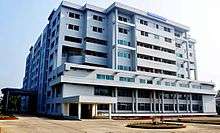
Apart from the usual agricultural products of Bangladesh, such as rice, wheat, potatoes and lentils, Rajshahi and its neighbouring regions are specially suited from various crops such as Mango, Lichi, Sugarcane, Potato, Tomato & Watermelon. In spite of being an important city and located on a riverbank, industrial development in Rajshahi has not taken place to any great extent. There is an Industrial Park in Rajshahi, which is now mainly home to industries producing products of the famous Rajshahi silk. Head office of regulatory board for Sericulture, Bangladesh Sericulture Development Board also based in the city. Rajshahi is also home to number of jute, textile and sugar mills, pharmaceutical and mango based industries. Two 50 MW power plants have already been built at Katakhali to meet the growing electricity demand of the city.
Bangladesh Bank, which is the central bank of Bangladesh has a regional office in the city. Rajshahi Krishi Unnayan Bank, a nationalised bank with its head office at Rajshahi is working in a mission to help to develop the agriculture sector of Rajshahi and Rangpur division. Barind Multipurpose Development Authority (BMDA), which is a government organization for the integrated development of Rajshahi & Rangpur division has its head office in the city.[10] Head office of Western Zone of Bangladesh Railway is located in this city.
Culture
Arts and festivals
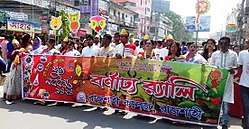
Rajshahi is known for its educational, literary and artistic heritage. Rajshahi is famous for Rajshahi silk, which has a special status as clothing material in Indian subcontinent. Along with neighborliness Chapai Nababganj, Rajshahi is the home of the regions best mangoes and lichis. Rajshahi is also the location of Barendra Museum which is known for its collection of local sculpture and other artifacts dating from medieval times. It also has some important structures that has made by the British like The T Dam. As an important city of Bangladesh, Rajshahi has a vibrant cultural life. Annual celebrations for Independence Day (26 March), Language Martyrs' Day (21 February) and Victory Day (16 December) are prominently celebrated across the city. Pohela Baishakh, the Bengali New Year, falls annually on 14 April and is popularly celebrated across the city. There are widespread celebration of Muslim festivals of Eid ul-Fitr, Eid ul-Adha, and Muharram; Hindu festivals of Durga Puja, Buddhist festival of Buddha Purnima; and Christian festival of Christmas across the city.
Media
There are many Bengali daily newspaper published from the city, which include Sonali Sangbad, Sunshine, Dainik Barta, Sonar Desh, Natun Provat, Amader Rajshahi & many more.[11] There are also online news portal such as Rajshahi News 24, Silkcity News etc. Government run Bangladesh Television and Bangladesh Betar have transmission centres in Rajshahi. Besides there is a local FM radio Radio Padma which transmits at 99.2 MHz frequency.Radio Foorti transmits at 88.0 MHz.
Sports
.jpg)
There are three 15,000+ capacity stadium in the city. One at the centre of the city which is normally called the Rajshahi District Stadium, another is inside the Rajshahi University and the last one basically used for cricket is located at Terokhadia called Quamruzzaman Stadium. There is also an international standard tennis complex and few sports training academy in the city.
Many national level footballers groomed in the city such as arguably the best goalkeeper in Bangladesh history. The city is the home of several national level club teams like Digonto proshari and Sonali Otit. There are also a few football training academies including one in the Rajshahi's central eidgah (large open ground used on special occasions for Muslim prayers) and in the Zilla stadium.
The city is an important place for cricket in Bangladesh. As regular supplier of cricketer in the national team, it is also the home of Bangladesh Premier League team Rajshahi Kings. The city has two cricket academies Banglatrack and Clemon, to grow and train upcoming cricketers.
Rajshahi is also known for hockey. There are many local hockey practice clubs that gives opportunity to play in National level, Inter University, college, School levels. There are National Team hockey players from Rajshahi. Late Mintu was one of them and by his name there is "Mintu Chottor" at lokkhipur mor, Rajshahi.
Transport

Rajshahi is well connected to the rest of country through roads, air and rail. There are plenty of rikshaw and autorikshaw available to travel within the city and adjacent area. Public buses and taxi's also available, though not plentiful. The horse driven cart was once a popular mode of transportation in this city, though rare to see nowadays.
Road
Rajshahi is connected to most other parts of the country via the N6 national highway. There are two intercity bus terminal in the city. It takes about 5 to 6 hours by road to reach the capital. A number of bus services, including air-conditioned and non-air conditioned buses, are available to and from Dhaka. Bus services to other major cities and districts headquarter are also available from Rajshahi.
Railway
Three Inter-City train services are operated by Bangladesh Railway, named "Silk City Express", "Padma Express" and "Dhumketu Express" between Dhaka and Rajshahi regularly. There are other inter-city, mail and local trains operated from here to connect Khulna and other region of the country.
Air
The city is served by Shah Makhdum Airport, named after the Islamic preacher Hazrat Shah Makhdum (Rh.), situated at Nowhata, which a commuter town of the city. Biman Bangladesh Airlines, Novoair, US-Bangla Airlines operates domestic flights to & from Dhaka.
Public transport
Cycle rickshaws and auto rickshaws is the main mode of transport within city & metro area. Once upon a time there were plenty of Tomtom in the city, which are also found but very rare nowadays. There are bus & minibus service in limited number of routes with suburban areas of the city. Plenty of Rent A Car agencies operate within the city and metro area, where Sedan/SUV/Micro-bus are available to hire on hourly or daily basis .
Healthcare
The city has many government, private & NGO run hospitals. Rajshahi Medical College Hospital (RMCH) is a tertiary level public hospital with teaching facility in graduate and postgraduate medical education. Other than RMCH, there is a children's hospital, one chest hospital, a district level government hospital & a Christian missionary hospital within the city area. There are two private medical college hospital and another two are under construction in the city.
Demographics
Population of the city proper is about 0.77 million.[3] Metro area (which includes satellite towns of Nowhata & Katakhali) has an estimated population of about 1 million.
Bengali is the main language for the citizens of the city. Many distinctive Bengali dialects and regional languages are also spoken.However English is understood widely, especially for academic & business purposes. There is a minority Urdu-speaking population, who are descendants of displaced Muslims from eastern part of British India who sought refuge during separation of India and Pakistan in 1947.
Literacy rate of the city is 74.1%. Islam makes about 86% of total population and about 13% people follow Hinduism, 1% follow other religion like Buddhist, Jain, Sikh and Christianity.
Education

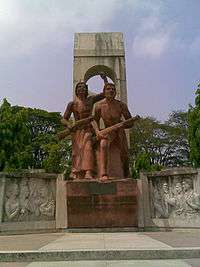
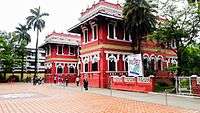
Rajshahi is an important educational centre and termed as 'Education city' of Bangladesh. It is home to many government and private educational institutions.The city is home to the Rajshahi College- which is the third oldest college in Bangladesh after Dhaka College and Chittagong College, Rajshahi Medical College- 2nd oldest medical college in erstwhile East Pakistan. The University of Rajshahi is the second oldest and one of the largest public universities in the country. Rajshahi Engineering College, now known as RUET was the second engineering college established in the then East Pakistan in 1964 (The first one was Ahsanullah Engineering College: now BUET).[12]
Major educational institutes include,
- University of Rajshahi
- RUET
- Rajshahi Medical College
- Islami Bank Medical College
- Barind Medical College
- Shah Mokhdum Medical College
- Varendra University
- North Bengal International University
- Udayan Dental College
- Islami Bank Medical College Nowdapara, Rajshahi
- Rajshahi College
- New Government Degree College, Rajshahi
- Government City College, Rajshahi
- Government Women's College, Rajshahi
- Varendra Government College, Rajshahi
- Haji Abul Hossain Institute Of Technology, Rajshahi
- Mohanogor College, Rajshahi
- Shah Mokhdum College
- Rajshahi Government Collegiate School
- Government Laboratory High School Rajshahi
- Rajshahi Education Board Model School & College
- Teacher's Training College
- Higher Secondary Teacher's Training Institute
- Silk Research and Training Institute
- Rajshahi Polytechnic Institute
- Rajshahi Mohila Polytechnic Institute
- Udayan Dental College, Rajshahi
- North Bengal International University
- Nowhata Degree College, Nowhata, Rajshshi
Notable residents
- Akshay Kumar Maitreya, noted Indian historian and social worker from Bengal.
- A.H.M Quamruzzaman, politician, National Leader and former Home Minister of Bangladesh.
- Ila Mitra, the leader of peasants and indigenous Santhals.
- Andrew Kishore, Singer
- Hasan Azizul Huq, Linguist, author, Story-writer.
- Khaled Masud Pilot, Former Captain of Bangladesh Cricket Team
- Mohammad Shamsuzzoha, academic, participant of Bengali Language Movement.
- Ritwik Ghatak
- Sir Jadunath Sarkar, historian
- Sabbir Rahman, Bangladeshi international cricketer
- Selina Hossain, novelist, Present Director of Bangla Academy
- Mrinal Haque, sculptor
Twin towns and sister cities
Rajshahi's twin town and sister city is:
-
 Kristiansand, Norway
Kristiansand, Norway
See also
References
Notes
- ↑ Government of Bangladesh refers to administrative seat of its divisions and districts as headquarters and not as capital
Citations
- FinancialExpress-bd.com, News about LSE survey
- Betar.org.be, Radio Bangladesh Website for Information on Bangladesh Betar
- World-Airport-Codes.com, Information on Shah Mokhdum Airport
- ↑ "Area, Population and Literacy Rate by Paurashava −2001" (PDF). Bangladesh Bureau of Statistics. Retrieved 19 August 2009.
- ↑ "Statistical Pocket book 2008, Bangladesh Bureau of Statistics"
- 1 2 "Rajshahi (Bangladesh): City Districts and Subdistricts - Population Statistics in Maps and Charts".
- ↑ "Rajshahi - Bangladesh".
- ↑ Saifuddin Chowdhury (20 January 2012). "800 years of Rajshahi city". The Independent. Dhaka, Bangladesh. Archived from the original (Print) on 2013-06-06. Retrieved 8 July 2011.
However, some scholars assume that Rajshahi is named so because of its Hindu kings and zamindars (Raj) and Muslim rulers (Shahi). Blockman, the British historian, thinks that during the Muslim rulers of Goura in the 15th century, the zamindar following the tradition of naming places according to their name or dynasty, for example, Mahmudshahi and Barbakshahi were named after Sultan Mahmudshah and Barbakshah respectively, Ganesh, Hindu king of Bhaturia (Raj) and his son Jalal Uddin who was converted into Muslim and took the title 'Shah' led to the fact of naming the region as Rajshahi. It means the word 'Raj' from 'Raja' (king) and its Persian synonym 'Shahi' connote the name 'Rajshahi'. But Henry Beverage discarded the anticipation of Blockman saying that the geographical distance between Rajshahi and the parganah of Bhaturia (the district of Dinajpur at present) is too much. Secondly, only one of the nineteen sarkers and six hundred forty-two parganahs in the revenue collection list of Raja Todarmal was familiar as Rajshahi. There is no mention of Rajshahi in the description of Ain-e-Akbari written by Abul Fazal, the most reliable reference book during the rule of Emperor Akbar. Even a parganah, let alone a sarker or mahal was named as Rajshahi. William Hunter thinks that the zamindary area of Ramjiban, king of Natore was known as Rajshahi and that name was adopted to name the district during the British rule. None of the explanations from the historic point of view can be accepted as authentic elements.
- ↑ Singh, Nagendra Kr (1 January 2003). "Encyclopaedia Of Bangladesh (Set Of 30 Vols.)". Anmol Publications Pvt. Limited – via Google Books.
- ↑
 Chisholm, Hugh, ed. (1911). "Rajshahi". Encyclopædia Britannica (11th ed.). Cambridge University Press.
Chisholm, Hugh, ed. (1911). "Rajshahi". Encyclopædia Britannica (11th ed.). Cambridge University Press. - ↑ "bbsgov.org".
- 1 2 Graham-Harrison, Emma; Doshi, Vidhi (17 June 2016). "Rajshahi: the city that took on air pollution – and won". The Guardian. Retrieved 9 July 2016.
- ↑ "BMDA".
- ↑ "পত্র-পত্রিকা".
- ↑ "Rajshahi University of Engineering & Technology - RUET". www.ruet.ac.bd. Retrieved 2016-12-02.
External links
- Map of Rajshahi District
- E-Rajshahi (in English), An online portal for information and government services managed by Rajshahi City Corporation
- RajshahiAd Listing site of rajshahi






